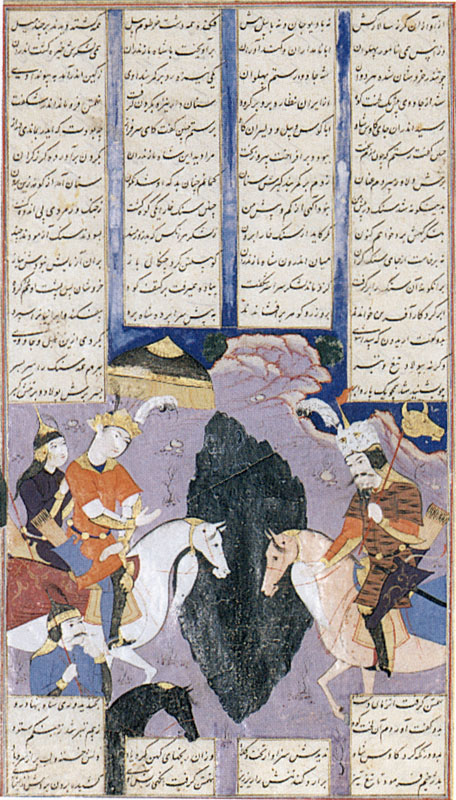Manuscript E, no. 2-074
The King of Mazandaran Changes Himself into a Rock
Location: Current whereabouts unknown
Page: 36.2 x 22.5 cm.
Painting: 13.3 (scaled) x 14.1 cm (not including extensions into the margin or between text columns)
Text area: 25.0 x 14.1 cm.
Text: four column; deepest column 19 lines on a 30 line per full page matrix.
Illustration number:
The number 20 written in black Arabic numerals in the left margin (not visible in this reproduction), presumably of later date, probably indicates that it was the twentieth painting in the manuscript.
In the battle Rostam finally broke through Mazandaran lines and confronted the king, who being possessed of magical powers, turned himself into a rock. Rostam, with his mighty strength, picked up the boulder and brought it before Shah Kāvos. This is the moment in the narrative that is here depicted. The composition is symmetrically organized with Rostam on the right, Shah Kāvos on the left, and on the central axis, a black rock that is the transformed King of Mazandaran -- his face barely perceptible in white outline at the top of the rock. The rigid symmetry of the composition is only broken by the addition of two soldiers on the left side that accompany the shah. Rostam, shown in his traditional garb of tiger-skin coat and leopard-skin headdress, and the shah with the umbrella of state held aloft over his head, are both on horseback, discussing what course of action to take. The backdrop in the lower portion of the painting is innocuous so as not to conflict with the main action taking place. The upper half of the composition, however, is more exuberant, with coral-like rock formations, diminutive shrubs, and a stormy sky.
There are four columns of text above and below the painting. At the top the two outside columns are each comprised of fifteen lines, and the center columns of twelve lines. Below the pattern is repeated, but the outside columns comprise four lines each, and the center columns two lines. A rectangular ruled frame encloses illustration and text except on the left side where a standard protrudes into the left margin. It is signed in the center of the lower margin in minuscule characters: raqam-e kamina moʿin-e moṣavver. Not dated.
Painting references:
Sothebys London 24 April 1996, Lot 59 (ill.).
Sothebys London 14 October 1999, Lot 46 (ill.).
Text references:
Warner, II, p.74. Mohl, II, p.445. Levy, p.57.
Photo after Sothebys.
Robert Eng
Last Updated: April 18, 2013 | Originally published: June 23, 1997
